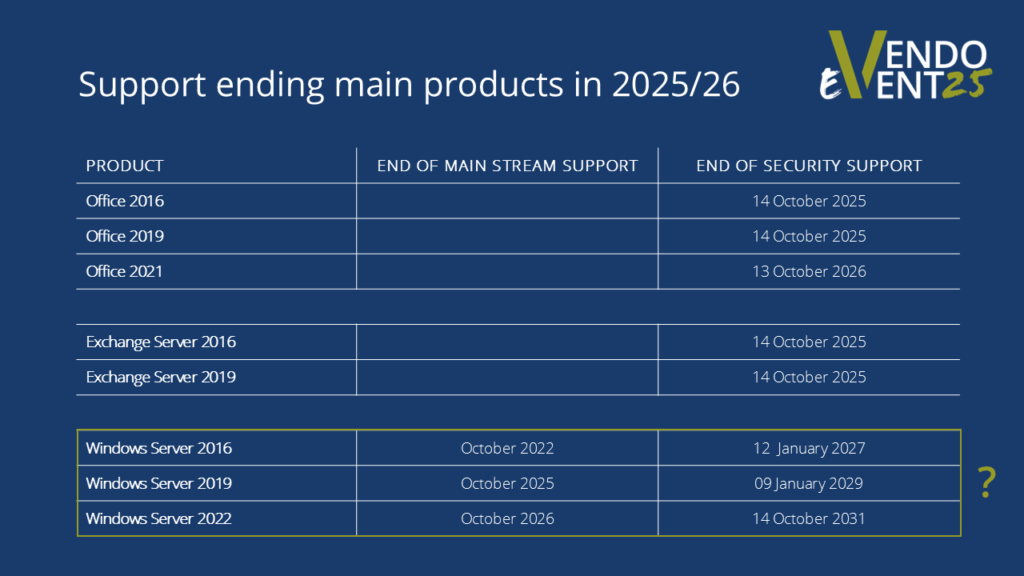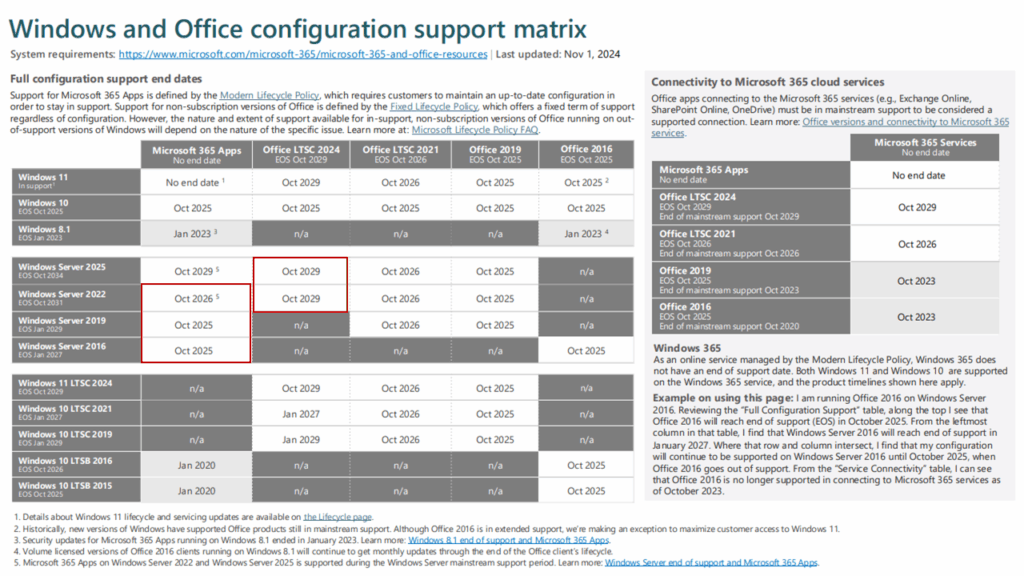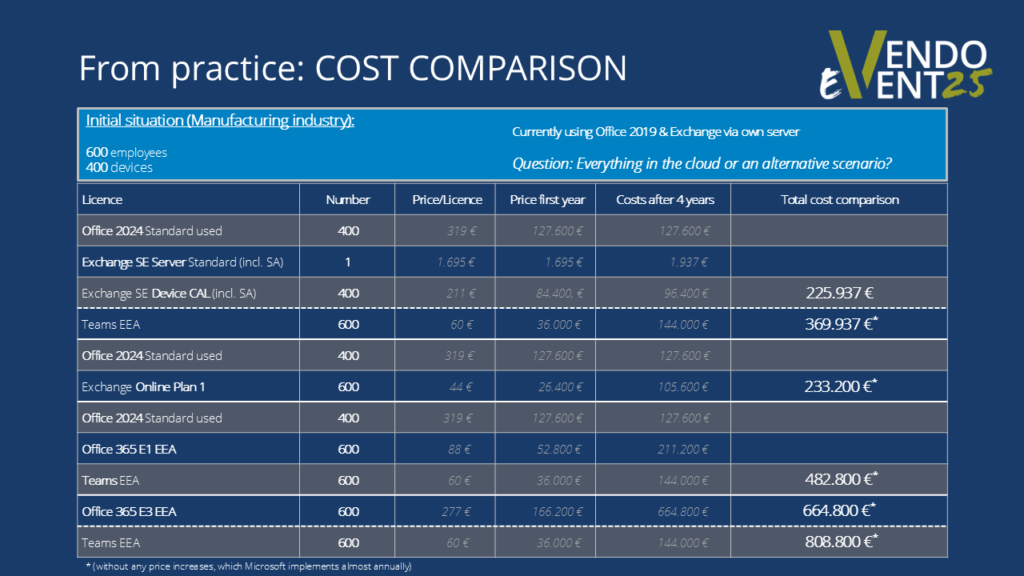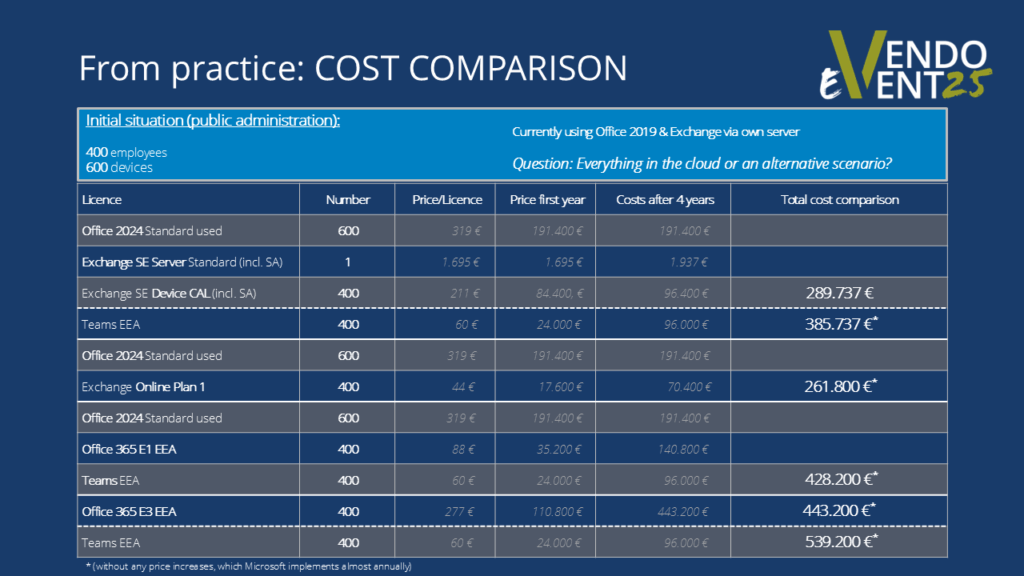Alternatives for the digital future
In today’s digital age, it is crucial for companies to be up to date with many technologies. With this in mind, Joyce Studier highlighted the upcoming end of Microsoft support for important licence products at VENDOeVent25 in Hamburg. Joyce is a Microsoft Licensing Professional, TÜV-certified SAM expert and a walking encyclopaedia in the VENDOSOFT team of licence consultants. This article summarises the key points of her presentation. It shows how companies can best prepare for the upcoming end of support and what options are available to them for post-licensing.
End-of-Life (EOL) of the most important Microsoft licences in 2025/26

Overview of Microsoft support end dates
Is M365 now a must-have?
“Is the path to the cloud virtually predetermined by the expiry of so many programmes?” Joyce asked her audience in Hamburg. The answer: yes and no. Yes, because the upcoming EOL makes the decision to switch to M365 easier. But the cloud is not a must. For at least another five years (and probably beyond), Office 2024 and the 2025 servers will keep all options open for on-premises licensing and hybrid models. However, the end of Microsoft support requires careful consideration and a thorough review of the alternatives.
The alternatives after Microsoft support ends
Options and key facts at a glance:
-
Office LTSC 2024 – the on-premises solution
-
- End of life: 9 October 2029
- Continues to include important applications such as Outlook, PowerPoint, OneNote, Word and Excel, as well as Access in the Pro Plus version
- No longer included: Publisher (as EOL in October 2026)
- Approved for use on terminal servers
- Minimum system requirements for optimal use: Windows 10 Pro / Windows 10 LTSC 2019 / Windows 10 LTSC 2021, Windows 11 and Windows Server 2022
Detailed product information
-
- Subscription model (no end-of-life date set) ensures continuous updates and improvements
- On-premises support continues: for licences with Software Assurance (SA), Open Value or in the Cloud Subscription Program (CSP)
- The InPlace Upgrade option allows you to upgrade directly from Exchange 2019 to the latest version. This simplifies migration.
- New features are expected with the cumulative update (Q3/25).
Detailed product information
-
- End-of-Life: 10 October 2034 (giving users a long-term planning framework)
- Mainstream support until October 2029 for continuous security updates and improvements
- Windows Server 2025 is mentioned here because the use of Office 365 requires certain versions of Windows Server. It may be necessary to use this server (see Compatibility section).
- If you want to purchase Windows Server 2025 now, it is important to know which products in your Microsoft universe are covered by mainstream support. Only these will remain compatible!
- The InPlace Upgrade option allows you to upgrade directly from Windows Server 2012 R2 to the new version. This makes migration easier.
- Windows Server 2025 continues to support Terminal Services, enabling a wide range of applications.
Detailed produkt information
-
Microsoft 365 – the cloud- alternative
-
- As a general rule, you should check whether the user’s licence metrics allow for cost-effective cloud usage (see the Cost Comparison section).
- Monthly licences offer companies a high degree of flexibility to adapt to changing requirements (no EOL), but are more expensive
- Advantages: including AI use & collaborative working
- Disadvantages: Downgrades and/or update delays not possible in the long term
- Please note:
- Take into account price increases every 1-2 years, which vary from 5 to 40% (last on 1 April 2025).
- Please note the 300-user limit for certain plans! More expensive 365 services apply above this limit.
- Only software under active mainstream support can be used to ensure that all features are available
Overview Microsoft cloud solution plans
-
Windows 11:
The end of support for Windows 10 was omitted from Joyce Studier’s analysis. The reason: In many cases, there is no alternative to switching to Windows 11. This often requires replacing the underlying hardware. VENDOSOFT is at your side with used licence versions – our cooperation partner Lenovo is available to answer your questions about hardware.
Please feel free to contact us to discuss your options for switching to Windows 10!
Compatibilities and pitfalls
An important aspect to consider when weighing up the alternatives is compatibility – i.e. the interaction between different licences and components. Compatibility issues arise when Office is used on terminal servers. To ensure full functionality, the respective EOL data should be taken into account when making a decision.
This is illustrated by the following example:

The matrix shows that Office 2024 is compatible with Windows Servers 2022 and 2025, while M365 can only be used on 2025 servers from October 2026 onwards. This is just one of many examples. Ask us, we’re happy to help!
Check the compatibility of your Microsoft licenses!
A cost comparison
Joyce Studier used two example scenarios to show the costs that could arise from new licences due to the end of Microsoft support. Her approach was to look at the various licence models and their financial implications over a period of four years to help companies make informed decisions about migrating to the cloud or alternative licensing options.
Scenario 1: For companies with more employees than devices, on-premises remains by far the more cost-effective solution. Businesses where this applies include production facilities, car dealerships and workshops – wherever employees share PC workstations. Joyce Studier advises these companies to buy Office second-hand, as the Exchange Server Device CALs are then significantly cheaper.

Scenario 2: Office 365 offers advantages in organisations with more devices than employees. For example, if desktop PCs, laptops and other devices are provided for home offices and office workstations. In public administrations with their multi-function scanners, it may also be wise to license by user rather than by device. On-premises remains cheaper in the long run, but the cost gap is smaller here.

Microsoft Teams was shown as an optional component in the charts. This highlights the significant cost differences between a pure cloud infrastructure and an on-premises variant.
Factors such as hardware, personnel costs, etc., which must be included additionally for on-premises solutions, have not been included in the cost analysis. Nevertheless, the figures provide clearly recognisable trends with regard to the costs for the different licensing models.
The end of Microsoft support offers oppertunities – and risks
At VENDOeVent25 in Hamburg, VENDOSOFT demonstrated that the end of Microsoft support for Office and Server offers an opportunity to switch to the Microsoft Cloud. At the same time, M365 is the more expensive solution in the long term. Companies must therefore carefully consider which future strategies they want to pursue and which products will enable them to implement these strategies successfully and cost-effectively.
Joyce Studier and her colleagues are here to help – with in-depth Microsoft licensing knowledge and many years of experience, they can help you find the right approach.
Book a free consultation
Contact form






